Introduction
Uganda was once home to two majestic rhino species: the black rhinoceros (Diceros bicornis michaeli) and the northern white rhinoceros (Ceratotherium simum cottoni). But due to the devastating effects of poaching, the mismanagement of their natural habitat, and prolonged and violent human conflict, both species were wiped out in Uganda by 1982.1https://ugandawildlife.org/animals/rhino/ At the end of the 19th century there were only between 20 and 50 white rhinos left in the whole of Africa but thanks to around the clock protection, there are now just over 18,000 white rhinos in the wild.2https://www.iucnredlist.org/species/39317/45814320#population Even though this reads like a success story, between 2012 and 2017, the rhino population decreased by 15 per cent.2https://www.iucnredlist.org/species/39317/45814320#population
In 2005, efforts were made to introduce the southern white rhino (Ceratotherium simum simum) to Uganda in Ziwa Rhino Sanctuary, now the only place in the country where you can find them.3https://ziwarhinoandwildliferanch.com/ Ziwa Rhino Sanctuary started with a family of six rhinos but is now home to 32 individuals. Even though the black and the northern white rhinos are lost forever, the hope is that the southern white rhino can be reintroduced to national parks across Uganda. The other 99 per cent of Africa’s southern white rhinos exist in just four countries: Namibia, Zimbabwe, Kenya, with the majority being found in South Africa. Rhinos live up to 40 years in the wild.
Fascinating facts
White rhinos aren’t white

Both the northern and the southern white rhinos are subspecies of the white rhino, but neither of them are white – they’re actually grey. They probably get their name from the Afrikaans word ‘weit’ which means wide, because of their wide mouths used for grazing on grass.4https://www.nationalgeographic.com/animals/mammals/facts/southern-white-rhinoceros
A crash of rhinos
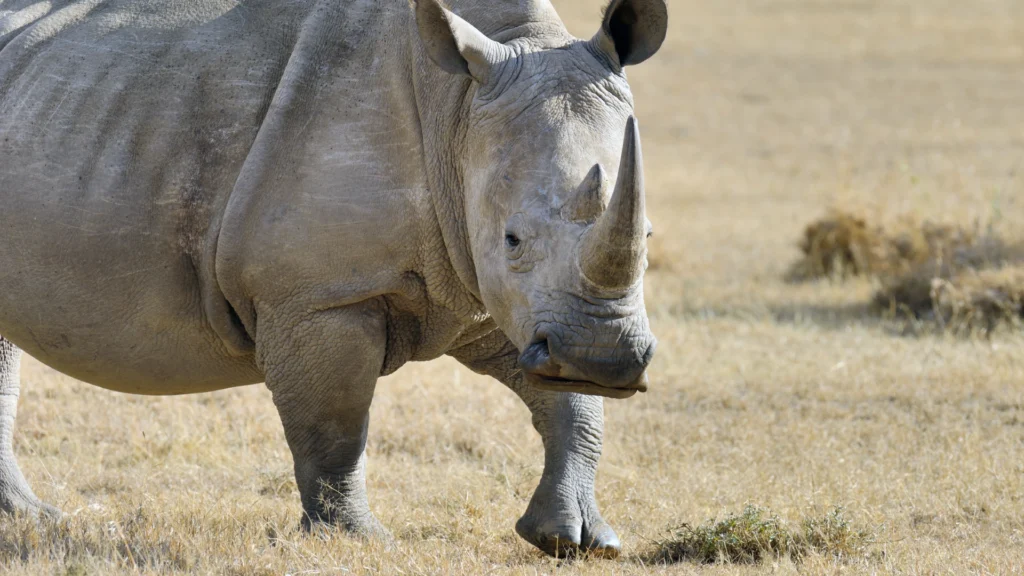
A group of rhinos is called a ‘crash’. Females prefer the company of each other, usually living in groups of around 14 members but the males tend to be more solitary. Rhinos are described as a semi-social animal. If threatened, a rhino will charge at the predator at 35 miles per hour, so ‘crash’ is a very appropriate description!
Rhinos mark their territory with dung
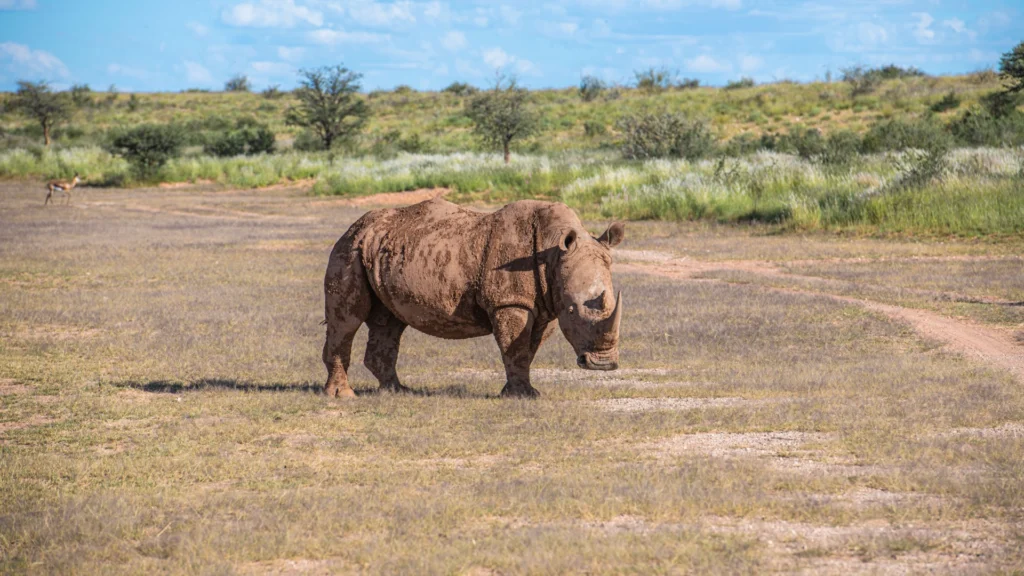
Adult male rhinos defend a territory of around one square mile. They create a border of dung piles and regularly patrol it to fight off any intruders and to stop any pregnant females from leaving.
The second biggest land mammal
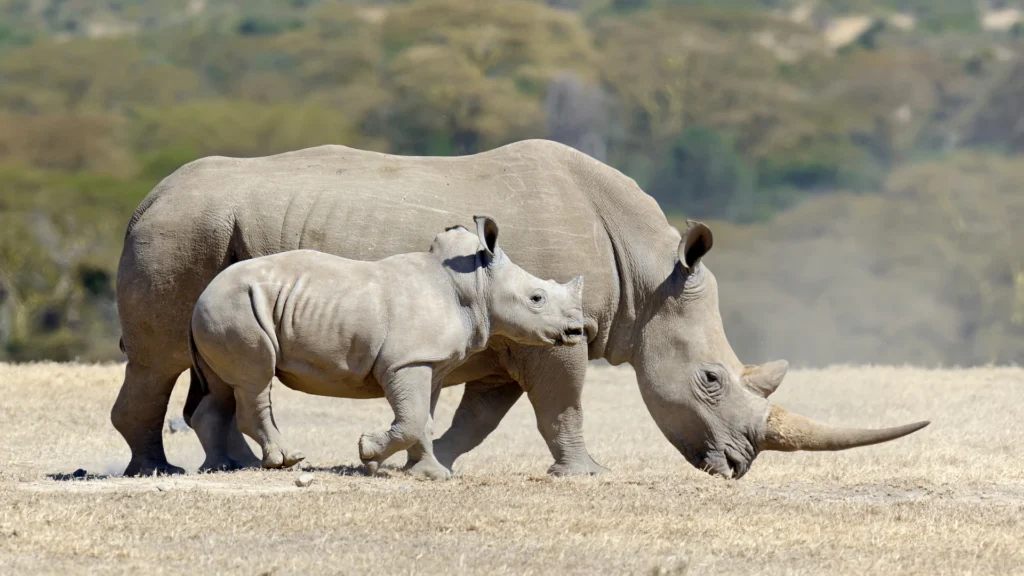
After the elephant, the rhino is the second biggest land mammal. Females weigh up to 267 stone (1,700 kg) and males tip the scales at around 362 stone (2,300 kg) – that’s heavier than a small car! They have a barrel-like body, a thick neck and huge head. Males can reach 13 feet (4 m) in length and stand 6.5 feet (2 m) tall.5https://www.britannica.com/animal/southern-white-rhinoceros
Plant-based powerhouses

Rhinos are herbivores and mainly eat grass. They need to eat over 50 kilograms (110 pounds) a day to maintain their hefty bulk. The southern white rhino is a connoisseur of grass and they prefer short grasses of seven to 10 centimetres.5https://www.britannica.com/animal/southern-white-rhinoceros
Rhino mating is mysterious

Little is known about the mating habits of white rhinos. We do know that the female is pregnant for 16 months and gives birth to one calf every two or three years. This slow reproductive rate is one reason why it’s so hard for rhinos to recover from population loss. After giving birth, a female rhino becomes very aggressive to protect her calf from danger. A rhino calf will stay with their mother for two to five years.
Rhinos are short-sighted
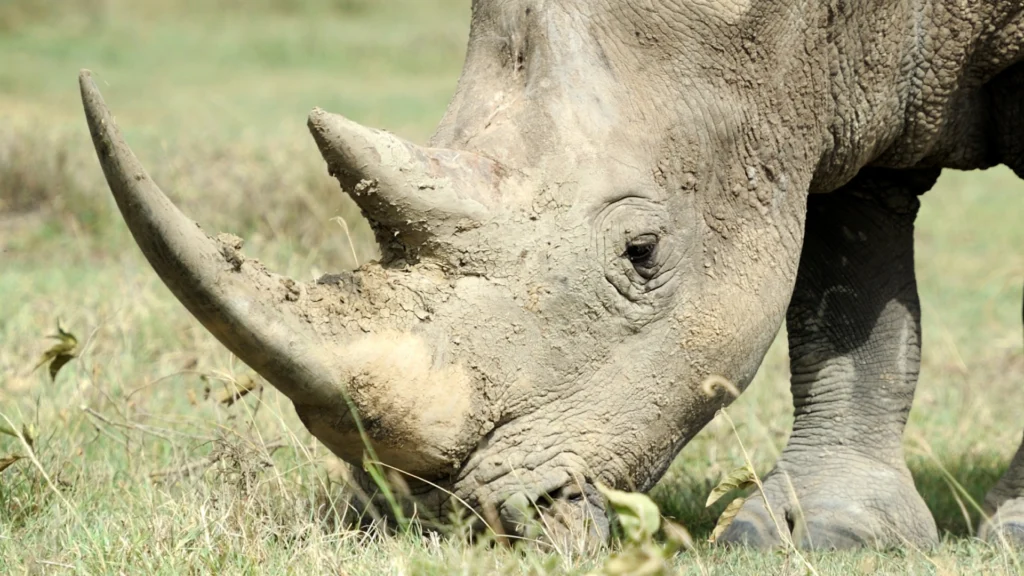
Rhinos don’t have very good eyesight but they have excellent senses of sound and smell. They can’t see someone standing still 100 feet (30 m) away, but they will be able to smell them.6https://www.wwf.org.uk/learn/fascinating-facts/rhinos
Rhino horns are made from the same stuff as our fingernails
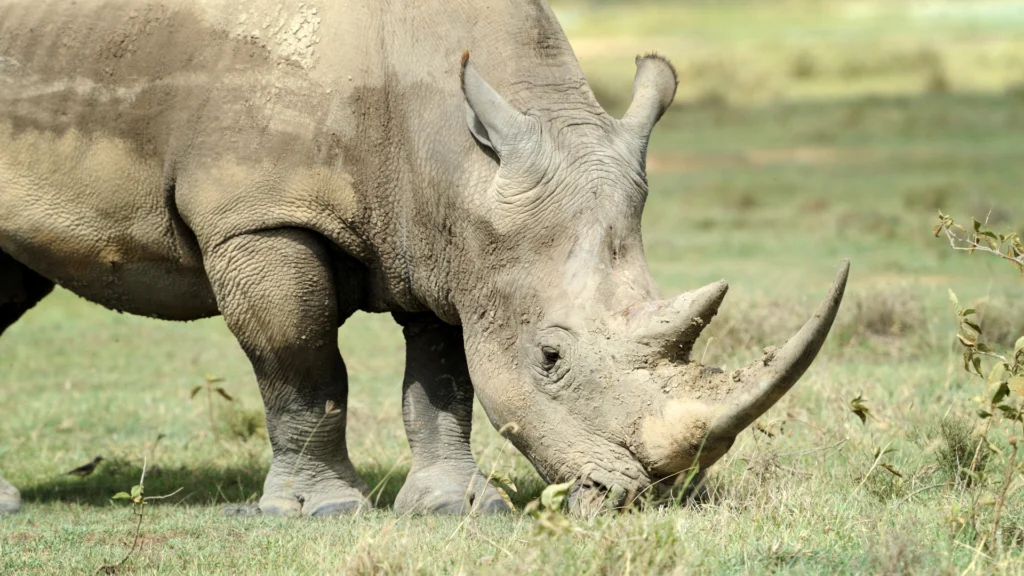
Unlike elephant tusks, which are effectively long teeth, rhino horns are made from keratin, which is the same protein that makes our fingernails and hair. The white rhino’s horn can grow seven centimetres a year and the longest recorded was almost five feet (150 centimetres) long!6https://www.wwf.org.uk/learn/fascinating-facts/rhinos
Threats to southern white rhinos
Poaching
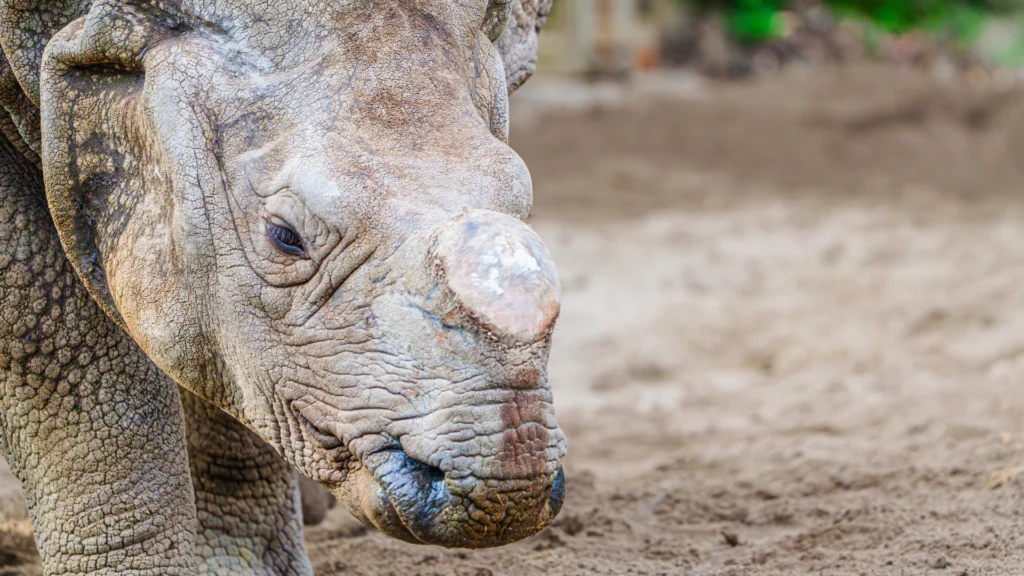
Poaching has been, and still is, by far the biggest threat to the existence of all species of rhino. Having once already been poached to extinction within Uganda, the few southern white rhinos in Ziwa Rhino Sanctuary only survive because of 24/7 protection.
Rhinos have long been poached for their horn and this continues today, with increasingly advanced technology making it easier for the poachers and much harder for the rhinos to escape. Sometimes, helicopters are used to track the rhinos, who are gunned down from above with AK-47s or tranquiliser darts. When the rhino is lying helpless, unable to defend her or himself, the poachers swoop in and hack off their horns with chainsaws. If the rhino wakes up, she or he is left to bleed to death from their atrocious wounds, as the poachers make a swift getaway.6https://www.wwf.org.uk/learn/fascinating-facts/rhinos It’s a nightmarish insult to the beauty of nature and a horrific way for any living being to die.
Almost all demand for rhino horn comes from China and Vietnam, where it is mainly used as an ingredient in traditional Chinese medicine.7https://www.savetherhino.org/rhino-info/threats/poaching-rhino-horn/ It is legal for certain doctors in China to prescribe rhino horn to treat a whole host of illnesses but there is absolutely zero evidence that it is effective. In fact, one researcher from the Zoological Society of London said “you’d do just as well chewing on your fingernails.”8https://www.pbs.org/wnet/nature/rhinoceros-rhino-horn-use-fact-vs-fiction/1178/ What’s more, even if rhino horn did prove to be effective against some illnesses (it’s not!), humans have no right to take it from the rhino.
Habitat loss

As with all wildlife in Uganda, the rhino has also been affected by habitat loss. Even if Ziwa Rhino Sanctuary is successful in reintroducing rhinos across Uganda, they will face the same difficulties as elephants, giraffes, lions and gorillas, just to name a few.
As the human population in Uganda increases, more land is converted into settlements and farmland, and fragmented by roads. Bit by bit, the rhino’s beautiful natural habitat is shrinking and being destroyed by the expansion of human infrastructure.
As a result of Uganda’s population growth, increased urbanisation, and an increased income for wealthier Ugandans, the demand for animal products is likely to dramatically rise in the coming years. The FAO estimates that by 2050, the demand for meat and milk products in Uganda will more than double and “the production of all types of meat and that of milk will increase by 164 and 41 per cent, respectively.”9https://www.fao.org/3/ca7009en/CA7009EN.pdf
In order to produce these animal products, land that was once beautiful and iconic savannah and forest – and a home to Uganda’s majestic wildlife – is being turned into farmland. The conversion of land to agriculture is stripping the wildlife of its natural habitat and putting increasing pressure upon the land to support life. In the last one hundred years, Uganda has lost 42 per cent of its forest cover, decreasing from 54 per cent to 12 per cent in 2017.10https://illuminem.com/illuminemvoices/deforestation-in-uganda-causes-and-recommendations Encroachment into Queen Elizabeth National Park by illegal cattle ranchers is common11https://conbio.onlinelibrary.wiley.com/doi/abs/10.1111/cobi.12538?campaign=woletoc and the National State of the Environment Report for Uganda 2014, attributes this to “the increasing demand of land for agriculture and fuel wood by the rapidly increasing population growth.”12https://nema.go.ug/sites/all/themes/nema/docs/FINAL%20NSOER%202014.pdf
What’s more, huge amounts of oil have been found under Murchison Falls, Uganda’s largest national park, and despite worldwide opposition by conservationists, French oil company TotalEnergies began drilling in the park in 2023 (9)
If rhinos are reintroduced, it will not be the same Uganda that it was 100 or even 50 years ago. They will have a lot less land and will be confined to the national parks and reserves. If humans continue to invade these natural habitats, it will become harder and harder for rhinos to find enough food to sustain their large appetites in a restricted and diminishing environment. Furthermore, as rhinos are more territorial than other large herbivores, such as giraffes, males are more likely to come into conflict with each other and cause injury if there is not enough space for them to coexist peacefully.
Of course, a growing population needs food but it would be much more sustainable to meet these needs through the growing of crops instead of farming animals. Animal agriculture requires by far the most land and resources – this is because land is not only used for grazing but also for growing food for the animals. The more animal-based foods we eat, the more endangered our forests become. However, crops are a far more efficient way to feed the growing population and use less land and other natural resources. A vegan diet is associated with only half the cropland demand, grazing intensity and overall biomass harvest of meat-based diets13https://www.nature.com/articles/ncomms11382 so switching to a vegan diet would have a phenomenal impact on reducing habitat loss and land degradation in Uganda.
References
References
- 1
- 2
- 3
- 4
- 5
- 6
- 7
- 8
- 9
- 10
- 11
- 12
- 13

